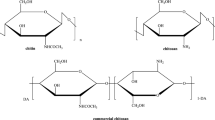Abstract
Purpose. The evaluation of the inhibitory action of two mucoadhesive poly(acrylates), polycarbophil and carbomer, registered by the Food and Drug Administration (FDA), on the intestinal proteolytic enzyme trypsin.
Methods. The effect of the polymers on trypsin activity by measuring the degradation of a trypsin specific substrate. Binding of Ca2+ ions and proteins (125I-BSA) to the poly(acrylates). The influence of the polymers on the secondary trypsin structure by circular dichroism.
Results. Trypsin inhibition was found to be time-dependent upon addition of Ca2+ in the degradation experiment. Only when Ca2+ was added within 10 min after trypsin incubation, recovery of the enzyme could be observed. Both polymers showed a strong Ca2+ binding ability. Carbomer, which had a higher inhibitory effect on trypsin activity, also revealed a higher Ca2+ binding affinity than polycarbophil. The amount of Ca2+ depleted out of the trypsin structure and the reduction of enzyme activity were comparable. Immobilization of trypsin by binding to the polymers could not be observed at pH 6.7. Circular dichroism studies suggested that, under depletion of Ca2+ from trypsin, the secondary structure changed its conformation, followed by an increased autodegradation of the enzyme.
Conclusions. The poly(acrylates) investigated may have potential to protect peptides from tryptic degradation and may be used to master the peroral delivery of peptide drugs.
Similar content being viewed by others
REFERENCES
J.-M. Gu, J. R. Robinson, and S.-H. S. Leung. Binding of acrylic polymers to mucin/epithelial surface: structure-property relationships. Crit. Rev. Therap. Drug Carrier Sys. 5:21–67 (1988).
C.-M. Lehr, F. G. J. Poelma, H. E. Junginger, and J. J. Tukker. An estimate of turnover time of intestinal mucus gel layer in the rat in situ loop. Int. J. Pharm. 70:235–240 (1991).
C.-M. Lehr, J. A. Bouwstra,, W. Kok, A. G. de Boer, J. J. Tukker, J. C. Verhoef, D. D. Breimer, and H. E. Junginger. Effects of the mucoadhesive polymer polycarbophil on the intestinal absorption of a peptide drug in the rat. J. Pharm. Pharmacol. 4:402–407 (1992).
V. H. L. Lee, R. D. Traver, and M. E. Taub. Enzymatic barriers to peptide and protein drug delivery. In V. H. L. Lee (ed.), Peptide and Protein Drug Delivery. Marcel Dekker, Inc., New York, 1991, pp. 303–358.
M. Saffran, G. S. Kumar, D. C. Neckers, J. Peña, R. H. Jones, and J. B. Field. Biodegradable azopolymer coating for oral delivery of peptide drugs. Biochem. Soc. Trans. 18:752–754 (1990).
C. Damgé, C. Michel, M. Aprahamian, and P. Couvreur. New approach for oral administration of insulin with polyalkylcy-anoacrylate nanocapsules as drug carrier. Diabetes 37:246–251 (1988).
I. Morishita, M. Morishita, K. Takayama, Y. Machida, and T. Nagai. Hypoglycemic effect of novel oral microspheres of insulin with protease inhibitor in normal and diabetic rats. Int. J. Pharm. 78:9–16 (1992).
C.-M. Lehr and V. H. L. Lee. Binding and transport of some bioadhesive plant lectins across Caco-2 cell monolayers. Pharm. Res. 10:1796–1799 (1993).
O. H. Lowry, N. J. Rosebrough, A. L. Farr, and R. J. Randall. Protein measurement with the folin phenol reagent. J. Biol. Chem. 193:265–275 (1951).
S. W. Provencher. Contin: A general purpose constrained regularization program for inverting noisy linear algrebraic and integral equations. Comput. Phys. Commun. 27:229–242 (1982).
E. A. van der Velde. Orthogonal regression equation. In A. M. H. P. van den Besselaar, H. R. Gralnick, and S. M. Lewis (eds.), Thromboplastin calibration and oral anticoagulant control. Martinus Nijhoff, Amsterdam, 1984, pp. 25–39.
H. D. Bartunik, L. J. Summers, and H. H. Bartsch. Crystal structure of bovine β-trypsin at 1.5 Å resolution in a crystal form with low molecular packing density—active site geometry, ion pairs and solvent structure. J. Mol. Biol. 210:813–828 (1989).
M. Delaage and M. Lazdunski. The binding of Ca2+ to trypsinogen and its relation to the mechanism of activation. Biochem. Biophys. Res. Commun. 28:390–394 (1967).
G. Salvesen and H. Nagase. Inhibition of proteolytical enzymes. In R. J. Beynon and J. S. Bond (eds.), Proteolytical enzymes: a practical approach. IRL Press, Oxford, 1989, pp. 83–104.
C.-M. Lehr, H. E. Boddé, J. A. Bouwstra, and H. E. Junginger. A surface energy analysis of mucoadhesion. II. Prediction of mucoadhesive performance by spreading coefficients. Eur. J. Pharm. Sci. 1:19–30 (1993).
W. R. Rypniewski, A. Perrakis, C. E. Vorgias, and K. S. Wilson. Evolutionary divergence and conservation of trypsin. Protein Eng. 7:57–64 (1994).
R. H. Kretsinger. Calcium-binding proteins. Annu. Rev. Biochem. 45:239–266 (1976).
D. Gabel and V. Kasche. Autolysis of β-trypsin—influence of calcium ions and heat. Acta Chem. Scand. 27:1971–1981 (1973).
Author information
Authors and Affiliations
Rights and permissions
About this article
Cite this article
Lueßen, H.L., Verhoef, J.C., Borchard, G. et al. Mucoadhesive Polymers in Peroral Peptide Drug Delivery. II. Carbomer and Polycarbophil Are Potent Inhibitors of the Intestinal Proteolytic Enzyme Trypsin. Pharm Res 12, 1293–1298 (1995). https://doi.org/10.1023/A:1016213405081
Issue Date:
DOI: https://doi.org/10.1023/A:1016213405081




